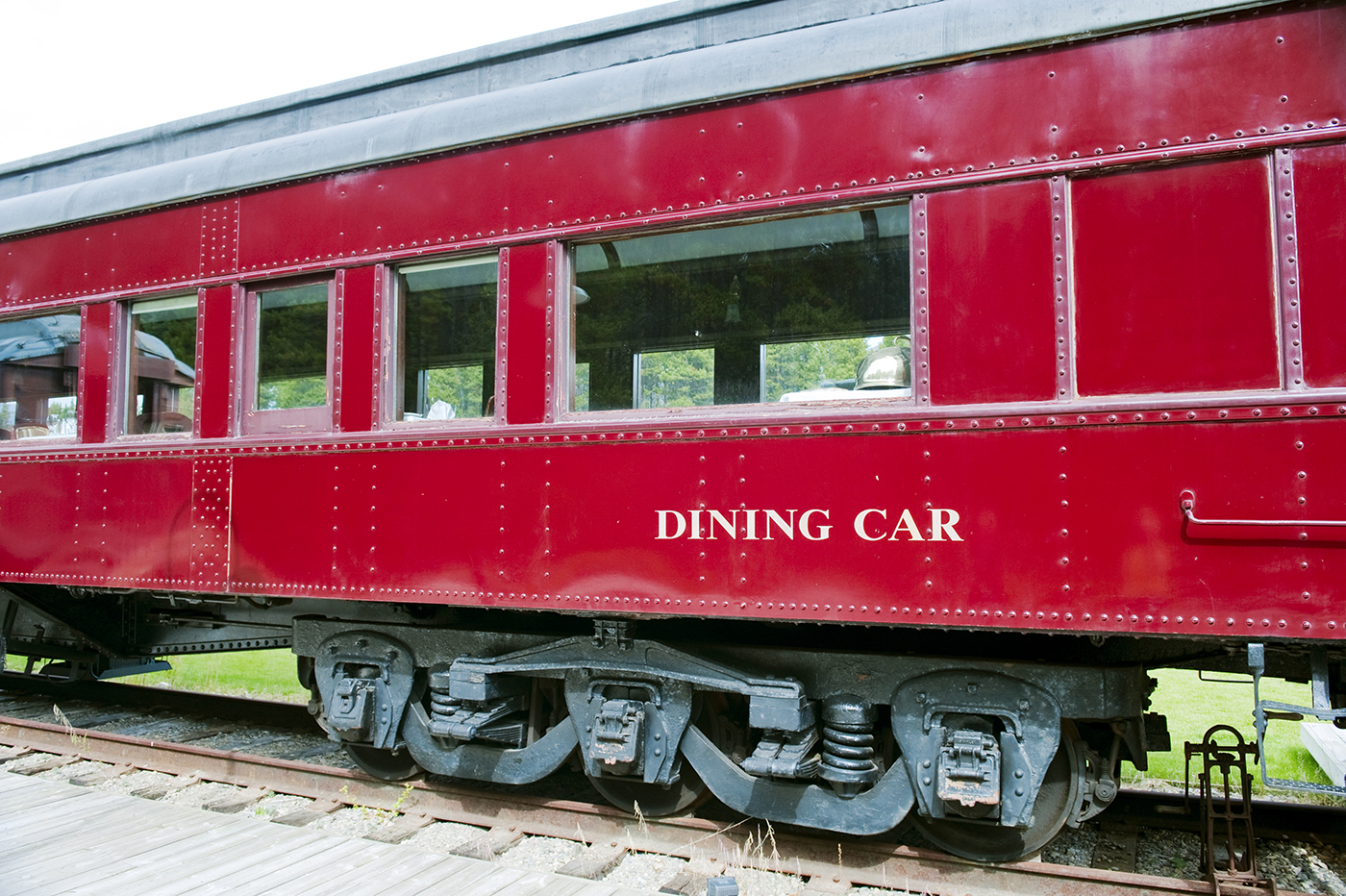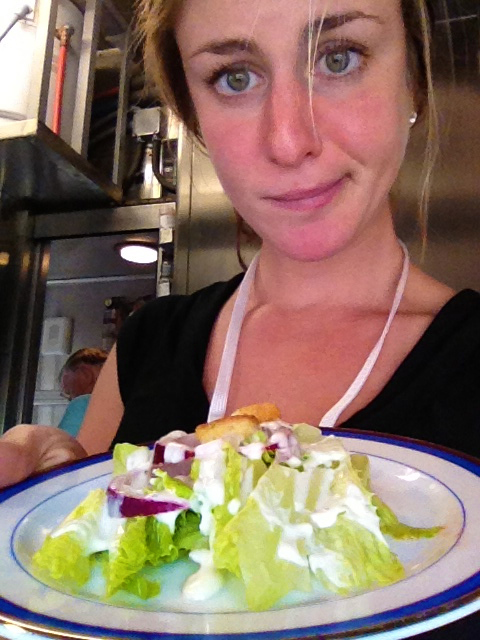There’s a spot for me at the dinner table, but I have nothing to say. We have nothing in common. I’m not married, I don’t like trains, and I can still touch my toes. It’s my first night aboard the rail car, and the only reason I’m sitting here is because I don’t yet know how to properly set the table. I just wish there were more greens. A month working on a train eating refined flour and store-bought cream pies is sure to leave me as anemic-looking as my current company. Some of them don’t eat vegetables.
The tracks are so rickety that I take my wobbling red-wine glass and squeeze it between my thighs. I don’t want to know how much this tablecloth would cost to clean, and I’m still unsure how much I get paid or what private rail porters actually do.
This “luxury train” thing is way out of my post-grad element. Sweaty, stressful trips on the NYC Metro and a few jaunts around Germany with a massive backpack have been my only train experiences. I was eager to end my unemployment slump with any job, just to be able to answer the annoying question, “So what are you doing with your life now?” This temporary train gig is my ticket to see this country in a way that most 20-somethings will never know. A porter-ology crash course informs me that I’m not only serving meals, but also making 1930s pop-out-of-the-wall beds and getting up close and personal with the insides of toilets.
After the meal, I awkwardly ask if I can help with the dishes. From that moment, I never stop doing dishes. No longer do I have a place at the table. I’m relieved. My place is now in the kitchen with chef Gerry.
“If you don’t like bodily fluids, you won’t like this job”: a strange thing to come out of a chef’s mouth, but that’s my first morsel of advice from Gerry Lemmons, 61, who looks strikingly like Abraham Lincoln. This is the ex-Broadway/now-nightclub piano performer’s 107th stint as a chef aboard a moving train. He tells me straight up, “Rails ain’t no restaurant.”
Before I get any more nuggets of wisdom, we have shopping to do in Seattle before our 10-day excursion to Los Angeles. I assume we’ll hit up Pike Place Market for Herculean salmon steaks and ripe grapes, but no. Instead we go to low-lit restaurant suppliers and Costco. “Not getting enough is the biggest mistake rail chefs can make,” Gerry says. After hours of filling oversized flatbed carts with cans of Cheez-Whiz, 12-pound bags of meatballs, and enough Bisquick to make Aunt Jemima run and hide, we have a grocery bill of over $1,100.
Gerry and I load our rental car to the ceiling and drive a mile past Seattle’s ornate King Street Station to the rail yard—which, no matter what city you’re in, is guaranteed to be sketchy as hell. Hiking across loose gravel, we clumsily cross active railroad tracks with armloads of food for our 16 passengers, who are forking out the big bucks (roughly $8,500) to travel back to the romantic rail era.
Passenger-train popularity may have been killed by Route 66 and America’s auto obsession, but a few privately owned, expensively refurbished yachts on rails survive, chartered through the American Association of Private Railroad Car Owners. Some owners run their cars out of Seattle on regularly scheduled Amtrak trains. Delivering the glamour of days gone by, these rail charters come complete with chefs, porters, and a silver-spoon serving of nostalgia.
Serving my first meal, I look and feel drunk. I dare anyone to pass a sobriety test—let alone serve scalding stew—while a train goes 80 mph. Now add antique china, spill-friendly red wine, and unlit candles, and you have rail dining. As diners try their best to cut braised duck delicately during a constant state of earthquake, I catch glimpses of misty Cascade pines out the kitchen window.
Before I’m finished clearing lunch dishes, Gerry shuffles into the 8´ x 6´ kitchen to start dinner. Between sips of Jack and Coke, he slips into his Southern Baptist alter ego, talking about other rail chefs. “Some of them think they can hop off the train in the middle of nowhere, North Dakota, and find flour in the 15 minutes the train’s stopped,” he tells me. “You see them running down the tracks.” Rule #1 of rail cheffing: Don’t miss the train.
Living by Murphy’s Law, rail chefs need to always be prepared for a kitchen apocalypse. Such as the time the train came to a screeching sudden stop to avoid hitting a truck on the tracks. “It looked like a bomb went off in the car,” Gerry remembers. Every glass was shattered, one woman broke her arm, and a man was left bleeding from the forehead. And in a very lavish, first-world setting, rail chefs will also encounter very third-world problems, like running out of water. The average rail car can store only about 300 gallons at a time.
Despite the burns and bruises that come with the territory, Gerry would never go back to a conventional restaurant kitchen. The ever-changing backdrop of window scenery and the challenges of cooking at high speeds provide the drama he craves. Propping his head against the microwave for balance, he beats eggs for cheddar-grits souffle (yesterday’s leftovers reincarnated). Add a sprig of parsley and they’ll never know.
During the Golden Age of rail, roughly 1900–1950, cars like mine entertained the likes of Bing Crosby and FDR, but today most passengers are retired rail fans, late into their years of rocking white sneakers and dad jeans—and let’s not forget a few eccentrics, like the token “foamer” (a rail fan who foams at the mouth at the sight of trains and is always equipped with a radio tuned to train-conductor jargon), or the gentleman on my car who insisted on having a sippy-cup of ice-cold Diet Coke at all times.
When it comes to feeding the baby boomers and beyond, most folks just want what their mommas used to make and their wives don’t. Our biggest culinary triumph is S.O.S., or “shit on a shingle”— a WWII treat of dried chipped-beef gravy over biscuits. Crab Imperial doesn’t go over as well, and the concept of purple potatoes is just too exotic. On some cars, it’s not uncommon for the salad course to be interrupted by someone having to reglue his or her dentures.
“I wish we could do the fun stuff,” Gerry says as we stand in the kitchen listening to big-band music. Some seared scallops or a nice Nicoise salad would be “fun,” but most of our passengers would rather eat hot dogs and off-brand Chips Ahoy.
Attempts to broaden our passengers’ palates are futile. Nearly all of the avocado tomato salad with a bright cilantro-citrus dressing (my idea) comes back to the kitchen, untouched. When meals flop, Gerry looks at me with tired eyes. “Time to face the music,” he says before shuffling into the dining room to chitchat with guests who simply don’t do avocado.
Rail passengers’ dining experience varies vastly from car to car, depending on what chef is hired and the size of their food budget. Some cars steam full lobsters, toss the leftovers, and spend $5,000 on dishwashers that boast three-minute cycles. Not us. “This is Southern cooking. We save everything,” Gerry says. With our no-waste mentality, we perform miracles with a single rump roast, serving it roasted with au jus, on sandwiches, and in stew.
Nevertheless, our guests (all at least 35 years my senior) seem to be enjoying themselves. They care more about the original railroad china from the 1930s than the meal being served on it. As they take countless photos of apple farms and vintage rail depots, I realize that this trip isn’t about the food. It’s about riding a train with an open bar, seeing historic landmarks, and hanging out with fellow rail buffs. If they have a full belly and a window seat, they’re happy.
As long as I stick to clearing dessert dishes and avoid talking to passengers about politics or marijuana legalization, we get along swell. Instead, I spend my time in the kitchen with Gerry, learning how to properly twist napkins and bridging our generation gap with a shared love of Sinatra. My life on the rails is simple: Eat. Clean. Relax. Repeat.
While the train crosses into Oregon, passengers clink wine glasses in the lounge. I sit on my new dinner table (a beer cooler in the corner) eating leftover bananas Foster. Later, Gerry teaches me how to foxtrot in the kitchen—and suddenly I dance back to an age when men wore hats and women waved hankies out of train windows. Even when I’m elbow-deep in dirty dishes, the magic of the rails is inescapable. Before one last cigarette break, Gerry tells me that, much like the era of rail, “I’d rather be a has-been than a never-was.”





